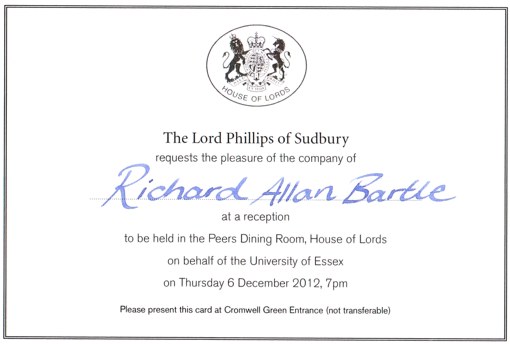
Security getting into the place wasn't too intrusive (so "just intrusive enough"). We all got a little lanyard with an identity photo on it. We had to hand it in when we left, but I guess the photo on mine must have come off or something:
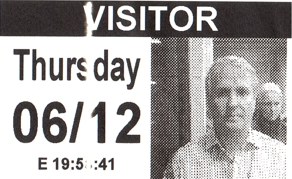
Once inside, wandering around was surprisingly easy. I was expecting to be escorted to the Peers' Dining Room, but instead we just walked where we wanted and asked the occasional police officer which way to go. I dare say that if I'd gone up the wrong staircase or tried to enter a committee room I may have been shot on sight, but access was very open.
The first part of the complex you get to enter after the security check is Westminster Hall. This is much bigger than I was expecting. Given that I was impressed by its dimensions today, it must have been absolutely staggering when it was constructed over a thousand years ago. Photos were allowed in here, so this is me being there:
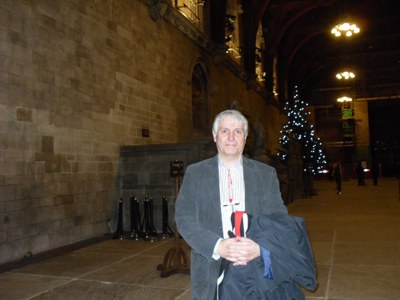
We spent an hour and a half in the Peers' Dining Room, or rather the lobby outside it. This is where we got to meet the other Essex University graduates present. I recognised a lot of them, but not because I actually knew them; I'd just seen them around during my time as either a student or a lecturer. There was a list of names of attendees; again, I recognised some of the names but I didn't always know why I did so. The list was not as helpful as it could have been, because it only had the names of the people who had applied for tickets on it: my wife, who hadn't applied (because I'd bought two tickets together) was not listed. Half the people there weren't listed. I'd have scanned the list for you but I loaned it to a graduate from 1970 with a random-letters-randomly-arranged Polish name and he never gave me it back.
I did meet someone I knew, though, a recent graduate I didn't teach but who used to show prospective Computer Science students around. He's now got a pretty good job working as a technical officer for an advertising agency and is probably paid more than I am. He has minions, too, which I don't. I was hoping to meet a student from my own year whom I haven't seen for 30 years but she'd said she was coming. I didn't see her, though, despite spending a lot of time looking. Then again, I didn't see the Speaker of the House, John Bercow, who was also there (in his capacity as an Essex graduate).
We weren't allowed to take photographs inside the Palace. This picture of a chair in House of Lords Red with the portcullis symbol on it (which they all have on them) must therefore have been taken by someone else:
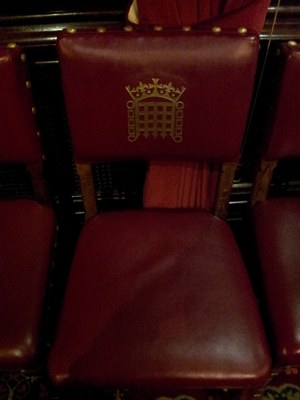
as indeed must this photograph of the ghastly wallpaper:
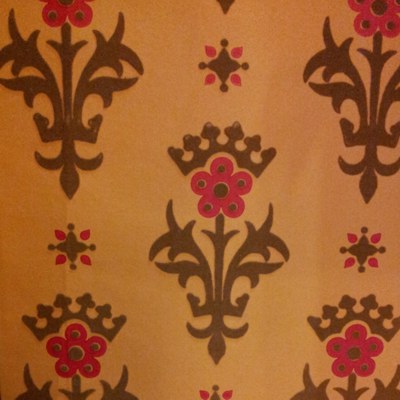
After a few tasty but entirely unfilling canapés, our tour began. The Houses of Parliament are colour-coded to confuse people with red/green colour blindness. Red is House of Lords; green is House of Commons. The Lords side is generally much more grandiose than the Commons side, as a result of a manufacturing error in the incendiary bomb that hit it (the one that hit the Commons burned it down). I knew that the tour would be taking us into the Chamber of the House of Lords, but I didn't realise we'd get to spend 15 minutes in there. It was a little shorter than I was expecting it to be, and there was less room at the throne end than I'd thought. The Woolsack, where the Lord Speaker sits, didn't look at all comfortable: it was like a 2m by 2m square tuffet. It has a backrest in the middle, but so far back that you'd have to have quite long legs in order to make use of it. There are some even bigger tuffets in front where the Law Lords used to sit, but as we don't have Law Lords any more I guess they'll eventually be removed or reassigned to members of the Supreme Court. The bishops sit on a bench to the Speaker's right, which has armrests at each end to separate them (as Lords Spiritual) from everyone else (the Lords Temporal).
There were a few concessions to modernity, such as timers (so peers know how long they've been speaking) and TV screens (so they know what the subject of the debate is) and microphones dangling from the roof (so they can hear what's being said, via the speakers in the benches). Most of it was only modern as of 150 years ago when this part of the palace was built. There was some wonderfully detailed wood carving in there that I'd have loved to have take a photograph of, but given that we were being watched to make sure we didn't sit on any of the benches, taking out a camera would have been imprudent.
The central lobby's purpose as a meeting place for people who want to buttonhole MPs (mainly other MPs, but also journalists and, er, lobbyists) was very impressive to look at, too. There was some very good mosaic (I think) work on the ceiling. Another antechamber near the Chamber of the House of Commons (called the Members' Lobby) was also interesting; it was relatively plain, but it had well-sculpted busts of twentieth-century prime ministers and four full-length bronze statues of four of them: Churchill, Lloyd George, Attlee and Thatcher.
I wasn't expecting our tour to take us into the House of Commons, because it was arranged by a Lord, but was very pleased to learn that it did. We went through a door dented over the years by the efforts of Black Rod, then into the No lobby. From there, we emerged behind the Speaker's chair and went into the Chamber itself.
I'd estimated the size about right, except that the Strangers' Gallery (where the public sits) went back a lot further than the debating chamber. The bullet-proof, sound-proof glass they have there isn't ideal (they don't have it in the Lords) but if you're televising proceedings then it does make sense not to encourage self-publicists. The floor of the House was of very human scale: it was easy to imagine a packed chamber, with people standing and sitting very close to one another. It also gave a much better sense of how short the distance between government and opposition MPs is — the TV pictures make them appear much further apart than they actually are. I much prefer this to the desk-based, horseshoe-style layout of more modern parliaments: when someone is right there in front of you, it must feel more as if you're dealing with individuals rather than parties.
Our tour guide was from North America; I'd guess the USA rather than Canada, because she didn't have that big deal with the letter R that many Canadians do. She'd been in the job 18 months, so did know quite a lot. Some of what she said confirmed what I already knew, although she did contradict my previous knowledge in places (sometimes correctly, sometimes less so — her explanation of why Margaret Thatcher has a full-length statue when she's not dead doesn't match what I've read elsewhere). Also, at one point she called the Elizabeth Tower "Big Ben", which drew shocked looks from her (by definition) well-educated audience. She was able to field questions very well, though: the only one she couldn't answer was one I posed at the end ("when did they forbid smoking in the building?", which admittedly is a little obscure).
In Westminster Hall on the way out, I took a look at what appeared to be the kind of thing you see in museums when they want to exhibit "remains". I was disappointed:
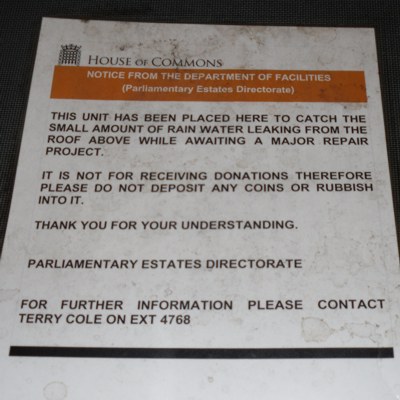
Finally, there was a little gift shop near where Westminster Hall joins the Saint Stephen's entrance (which was reconstructed after the fire of 1834 so as to resemble the original chapel that had been repurposed as the House of Commons some centuries earlier). There were lots of things on offer, but I only found one item I actually wanted:
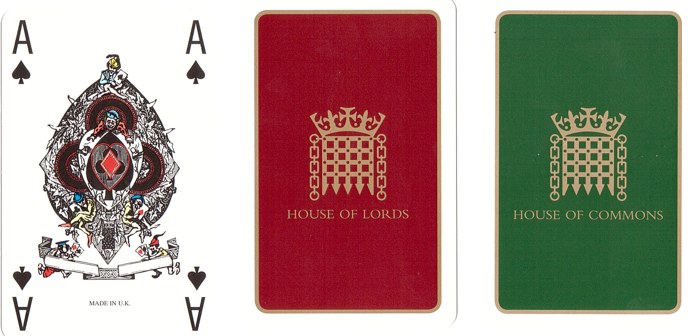
Well what else was it going to be?
Overall, I really enjoyed it. Seeing the seat of power gives an insight into the wielding of power. I came out of it actually more affirmed in Britain's democratic traditions than I was when I went in, mainly because of the way the House of Commons was constructed.
I wish they'd chosen a different wood for the Speaker's chair, though. That black beanwood from Australia doesn't really look right alongside the rest of the wood in there.